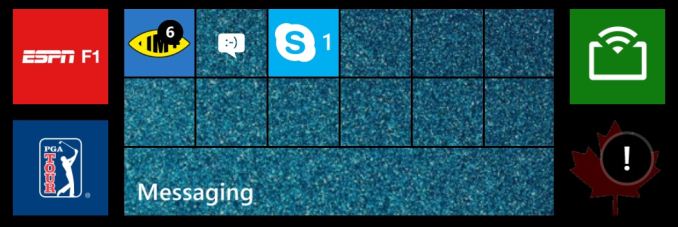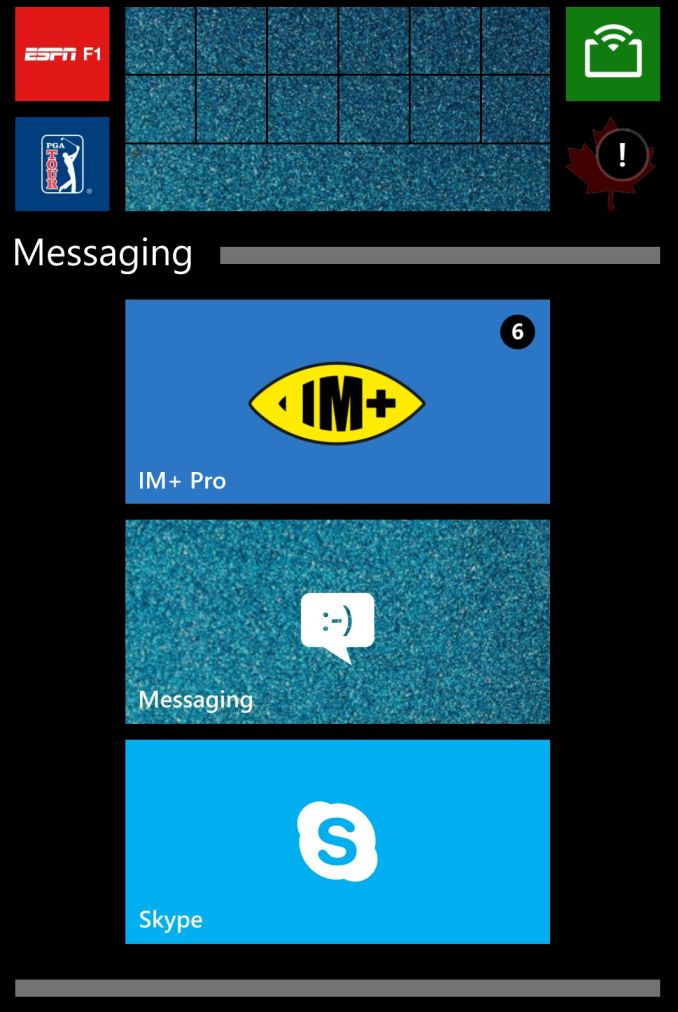Nokia Lumia 930 Review
by Brett Howse on September 8, 2014 3:00 PM EST- Posted in
- Smartphones
- Microsoft
- Nokia
- Mobile
- windows phone
- Lumia
Software
Like the Lumia 630, the 930 ships with Lumia Cyan firmware, which adds a few additions to the phone. Unlike Android phones, there is no customization of the operating system itself, so in this section we will take a look at several of the unique Nokia apps as well as improvements to Windows Phone 8.1 since it launched a few months ago.
As with the Lumia 630, Cyan finally brings adjustable display brightness as well as advanced color profiles. In addition, the lock screen timeout can now be set to “never” which was not always possible on older Nokia Windows Phones.
You also get access to the excellent HERE branded navigation apps, with HERE Drive+ for driving, HERE Maps as a general navigation app, and HERE Transit for using public transportation. They are a great alternative to Google Maps, which, as with most Google services, do not exist as a first party app on Windows Phone.
SensorCore, explained in the Lumia 630 review, is a low power portion of the Snapdragon 800 SoC which allows the phone to act like a pedometer. At IFA 2014, Microsoft announced that SensorCore is going to expand its capabilities this fall as well with the addition of "Hey Cortana" passive activation of Windows Phone's digital assitant to bring it parity with "Ok, Google" on the Android platform.
Microsoft is in the middle of transitioning the Nokia branded apps to Lumia apps, which makes sense with the acquisition of Nokia a few months ago. One example is the Nokia Storyteller app, now rebranded Lumia Storyteller. Storyteller collects your photographs and groups them by date and location into videos set to music, similar to HTC’s highlights reel. It is a neat feature and it does a good job with the photos if you like that sort of thing.
Storyteller works in conjunction with the “capture living images” option in the camera settings. This setting makes the camera capture a short amount of video prior to each photo being taken. Then, when scrolling through your camera roll, the images will have a bit of movement to them. It is an interesting, if creepy effect. This setting does not affect the still photo itself and must be stored separate from the image. Here is a video from Nokia showing it in action.
If living images in your camera roll creep you out, you can disable them in the Nokia camera settings.
The latest version of Windows Phone also brought some changes that are worth mentioning. First, the browser has been enhanced to give a better mobile experience. It has certainly helped out with mobile sites, with the caveat that you will often be offered access to the iPhone app for a site. One thing that would still be a great addition to Windows Phone’s browser is a navigation button to jump to the top of the page. Hopefully this will come soon.
 IE 11 old (left) IE 11 new (center) Safari (right)
IE 11 old (left) IE 11 new (center) Safari (right)
The other major addition since Windows Phone 8.1 was launched is native folder support. Being Windows Phone, these folders would not be much good if they did not support the live tile nature of the operating system, so they are live folders. To create a folder, do a long tap on a live tile and then drag it over another live tile. Tap a folder to expand it, and tap again to close it up. It is fast, simple, and actually works really well.
In addition, Bluetooth is updated for PAN 1.0 profile, aptX codec support for A2DP, and browsing support for AVRCP are now supported. NTP was for some reason never supported in earlier versions of the OS, with Windows Phone instead relying on carriers providing the time over the cellular network. That is not ideal as not all carriers do this properly, and if you do not have a SIM in your phone your time must be set manually, and then it wipes it out every time you reboot. This obvious addition of NTP support rectifies these shortcomings. For a full list of the changes, please see this page.
It always seems like Windows Phone is behind a bit compared to other mobile platforms, but these incremental updates are a good step to closing that gap. There are quite a few behind the scenes changes as well for this update so if Microsoft wants to have any chance to catch up, this is important.













115 Comments
View All Comments
Arbie - Monday, September 8, 2014 - link
SD police here...So my low-end Nokia 520 has microSD, which lets me easily swap in TV series that I watch when traveling or to kill time waiting somewhere. A new 930 at much higher price won't let me do that.
Hmmm... my love affair with Nokia (the 520 is great) will be coming to an end.
Windows Phone doesn't even have the flimsy excuses of the Android camp for no SD. It can even be read-only dumb storage, with no security issues. But no.
Not interested / will never buy it.
tuxRoller - Monday, September 8, 2014 - link
The Android issues aren't with security but, from what a Dev claimed (falsely, IMO) poor user experience.NikAwesome - Tuesday, September 9, 2014 - link
SD, mSD or whatever external storage are at least an order of magnitude slower than eMMC or ONFI or more advanced NAND interfaces. When an application like the Photo Gallery browser has to read lots of pictures from SD it is really a torture (several seconds, or tens of seconds). In the first eras of tablets and smartphones, people get accustomed that all has to launch in less than second (give or take), faster than their desktop application launch at home/work. So in this context, several seconds is inappropiately interpreted as sluggish CPU performance when the real bottleneck is in the storage IOs. These delays severely impact usability if you are used to full internal flash storage, where everything opens in under a second.I am not against mSD cards, I have an 8GB S4 mini and 32 GB mSD. I can easily tell the performance difference, but I have no choice if I want to take lots of pictures or film lost of 1080p videos.
Summing up, performance is the real reason why Google do not allow external storage on their devices (Nexus smartphones and tablets). From Apple point of view is arguable that they had contracts with music label records inheriting the iPod policy: "easy to load music into the device, a pain in the ass to extract it in order to make piracy more difficult"
jimbo2779 - Tuesday, September 9, 2014 - link
If you think sd cards make viewing photos on a phone a chore them it could be your phone or its support of SD cards that is at fault on the Lumia 620 there is no noticeable difference between photos on the phone memory and in SD card.Also there seems to be very little difference, if any, between the 620with all pics on SD and a925 with no SD support so speed is not a reason.
tobi1449 - Tuesday, September 9, 2014 - link
Plus: What's worse, photos that take a little bit longer to load or photos that either don't load at all because you don't have them with you or take much much longer and half of your free data?marcokatz - Friday, September 26, 2014 - link
Well Nokia sure is trying, but Microsoft is not exactly helping them out (they even released their own app for iPhone first... gosh). Anyway, as of today it's much better to go for one of the really good Android phones. /Marco from http://www.consumertop.com/best-phone-guide/tuxRoller - Tuesday, September 9, 2014 - link
That wasn't the reason given, iirc. The problem he mentioned was one of user removes sdcard, doesn't see his photos/apps on phone and gets confused. The other issue was technical, but, again iirc, was fixable if they wanted.jimbo2779 - Tuesday, September 9, 2014 - link
While that is the one technical issue with SD card implementation I would say there is a very small amount of people that would be able / willing to switch out the SD card and not be aware that they would be missing the contents of that SD card when they go into their photos app.When you remove a DVD from your computer do you wonder why you can't watch your favourite film anymore? Would anyone?
I am sure it has happened to someone at some point but realistically how many people would that affect compared to the amount of people that would put an extra 32 or 64 Gb in their phone and just be happy to have doubled or tripled their storage to keep a years worth of photos and videos of their kids on their phone.
Either way you look at it having the option to massively extend the amount of internal storage to have more media / apps in your phone is more favourable to most compared to having to resort to the cloud (which is just a no-go for a good portion of smartphone users across the world) or constantly removing stuff to make the newest stuff fit.
I would miss Glance but without SD card I will not be buying this which is a shame I was looking forward to it, don't even get me started on how the rumours for the 830 got me all excited and left me disappointed when the phone was finally announced. Either the 830 or 930 could have been WP halo phones for a lot of potential detractors to the WP platform, instead they are just a few tweaks short of stacking up very favourably with their android competition.
tuxRoller - Tuesday, September 9, 2014 - link
The technical issue was actually brought up by the poster below me (pjcamp). It was regarding creating a unified storage space across multiple devices.To be clear, I am NOT saying these were good reasons, I only brought them up in response to the parent who I thought MIGHT have been claiming that the reasons android dropped sd card support was related to security.
I really wish that sdcards (or some other removable storage standard) made a comeback on android.
Rama TT - Saturday, September 13, 2014 - link
"""Summing up, performance is the real reason why Google do not allow external storage on their devices "" Yeah right and it has nothing to do with Google Drive